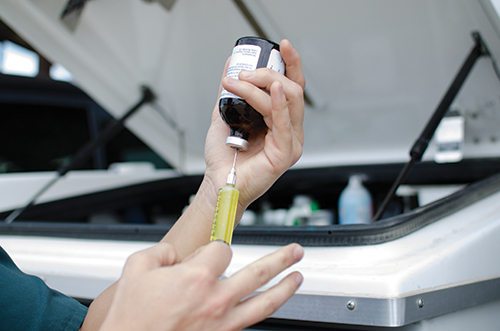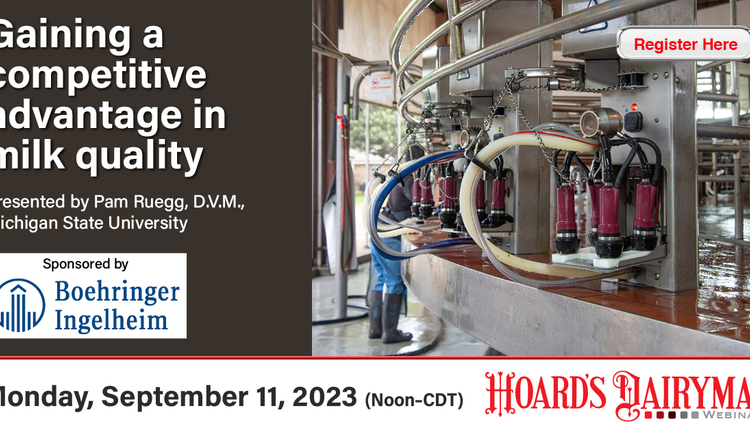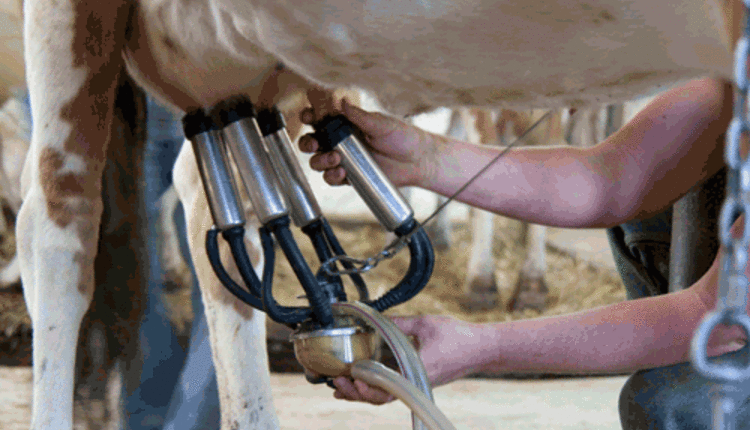The author is a dairy science professor and extension milk quality specialist with the University of Wisconsin-Madison.

Read the labels of drugs commonly used on your dairy, and understand how and when they should be used. Establishing a VCPR and usage protocols can lower your meat and milk residue risk.
Successful dairy farmers work hard to prevent disease, but sometimes cows develop illnesses that require the use of antibiotics or other pharmaceuticals. The use of drugs in animals that produce food is highly regulated, and consumers expect residue-free products. While most milk and dairy beef is produced from healthy, residue-free animals, when drug residues occur, they are usually the result of mistakes in usage of a product or a result of communication failures. The best way to maintain and minimize the risk of residues is to work closely with your local veterinarian and make sure everyone who administers drugs understands the regulations.

Successful dairy farmers work hard to prevent disease, but sometimes cows develop illnesses that require the use of antibiotics or other pharmaceuticals. The use of drugs in animals that produce food is highly regulated, and consumers expect residue-free products. While most milk and dairy beef is produced from healthy, residue-free animals, when drug residues occur, they are usually the result of mistakes in usage of a product or a result of communication failures. The best way to maintain and minimize the risk of residues is to work closely with your local veterinarian and make sure everyone who administers drugs understands the regulations.
Know your labels
The first step to ensure responsible drug usage is to read, and be sure that you understand, all the labels on all products that are used on your farm. The labels describe the illnesses that the products are approved to treat, the dosages that should be given, and the withholding periods for meat and milk. If drugs are used in a manner not described on the label, then the withholding periods for meat and milk are not applicable, elevating the residue risk dramatically.
The FDA is responsible for ensuring the safety of U.S. food products, and FDA regulations govern the use of drugs on dairy farms. These regulations have evolved over time and can be confusing. For example, some drugs are approved for usage only in nonlactating cows. Most farmers would probably agree that the definition of a lactating cow means that the animal is producing milk; however, the FDA has a different definition.
According to the FDA, all female animals 20 months of age and greater are defined as lactating cows, regardless of whether or not they are producing milk. That means that drugs approved for use in nonlactating cows cannot be administered to heifers greater than 19 months of age or to adult cows during the dry period, except under the guidelines that apply to extra-label drug usage.
Various types of drug usage are legally permitted on dairy farms. The easiest type of usage to understand is referred to as "over-the-counter" (OTC). Over-the-counter usage is approved for a few drugs, such as penicillin. However, OTC usage only applies when those products are used to treat the conditions described on the product label and only when the exact label dosage is used.
A typical label for OTC penicillin includes treatment of bacterial pneumonia using a dosage of 3,000 IU/pound (1cc/100 pounds). The label also says that the product should be given for no more than four days and by administration of no more than 10cc in any one site. Any deviation from any of those indications is not considered OTC and, therefore, must be done under supervision of a veterinarian.
The second type of allowable usage is referred to as prescription. Prescription products cannot be purchased without veterinary authorization. Still, just like OTC, exact label specifications must be followed. If the product is used in a manner not described on the label, an additional veterinary label for extra-label usage is required.
The use of Banamine (flunixin meglumine) for treatment of acute bovine mastitis is one example of prescription usage as the product label includes instructions for its treatment. A veterinary prescription is required, but if administration follows the label directions (2 mL/100 pounds given once by intravenous administration), then it is appropriate to follow the specified milk and meat withholding periods.
However, the validity of the withholding periods is based on the labeled dosage and route of administration. If the product is given in the muscle or subcutaneously, or given for more days then specified, the usage would be considered extra-label. These extra-label guidelines are important because, if the rules for prescription usage are not met, the labeled meat and milk withholding periods are no longer sufficient.
Veterinary relationship a must
Extra-label usage refers to any use of a drug that is not specifically listed on the drug's label, and it is only permitted under the guidance of a local veterinarian who meets the criteria defined for a valid veterinary-client-patient relationship (VCPR). In general, the criteria for having a valid VCPR infers that the veterinarian has assumed the responsibility for making medical judgments regarding the health of the animals and the farmer has agreed to follow the instructions. The criteria also specify that the veterinarian must have sufficient knowledge of the animals, be able to arrive at a general diagnosis of the medical condition, and be readily available for follow-up in case there's an adverse reaction to the drug or the treatment protocol fails.
One practical way to ensure that you have a valid VCPR is to have a written agreement with your veterinarian of record that specifies he or she is responsible for providing oversight of drug usage on your farm. The veterinarian of record should be the person whom you would work with to establish written treatment protocols, and this veterinarian should perform training about proper administration of drugs and review treatment outcomes.
Some extra-label usages of drugs are surprising. For example, in the U.S., only intramammary antibiotics are approved by the FDA to treat mastitis. Therefore, the use of any injectable product (anything given in the muscle, under the skin or IV) to treat mastitis is considered extra-label usage and must be performed based on guidance of the veterinarian who holds the VCPR for the farm.
Not all drugs are approved
While extra-label drug usage is allowed, it is important to recognize that not all drugs can be used in lactating dairy cows, even by veterinarians. Some drugs are prohibited, and others are restricted. Prohibited products cannot be used by anyone to treat food animals, and restricted products cannot be used in an extra-label manner. An updated list of prohibited and restricted products can be found here.
One example of a restricted drug is the use of sulfonamides; no extra-label usage is allowed in adult dairy cows. Application of this rule is confusing. For example, sulfadimethoxine (Albon) is the only sulfonamide that is labeled for use in lactating dairy cows. However, the label specifies that this drug is approved only for treatment of bovine respiratory disease, necrotic pododermatitis (infectious foot rot) and calf diphtheria. The use of sulfonamides for treatment of other conditions (such as mastitis) is prohibited, even under veterinary supervision.
Likewise, extra-label usage of fluoroquinolones (Baytril and A180) is prohibited, and use of these compounds for treatment of bovine mastitis or any other condition cannot be justified.
More information about responsible drug usage can be found by clicking the link.
The first step to ensure responsible drug usage is to read, and be sure that you understand, all the labels on all products that are used on your farm. The labels describe the illnesses that the products are approved to treat, the dosages that should be given, and the withholding periods for meat and milk. If drugs are used in a manner not described on the label, then the withholding periods for meat and milk are not applicable, elevating the residue risk dramatically.
The FDA is responsible for ensuring the safety of U.S. food products, and FDA regulations govern the use of drugs on dairy farms. These regulations have evolved over time and can be confusing. For example, some drugs are approved for usage only in nonlactating cows. Most farmers would probably agree that the definition of a lactating cow means that the animal is producing milk; however, the FDA has a different definition.
According to the FDA, all female animals 20 months of age and greater are defined as lactating cows, regardless of whether or not they are producing milk. That means that drugs approved for use in nonlactating cows cannot be administered to heifers greater than 19 months of age or to adult cows during the dry period, except under the guidelines that apply to extra-label drug usage.
Various types of drug usage are legally permitted on dairy farms. The easiest type of usage to understand is referred to as "over-the-counter" (OTC). Over-the-counter usage is approved for a few drugs, such as penicillin. However, OTC usage only applies when those products are used to treat the conditions described on the product label and only when the exact label dosage is used.
A typical label for OTC penicillin includes treatment of bacterial pneumonia using a dosage of 3,000 IU/pound (1cc/100 pounds). The label also says that the product should be given for no more than four days and by administration of no more than 10cc in any one site. Any deviation from any of those indications is not considered OTC and, therefore, must be done under supervision of a veterinarian.
The second type of allowable usage is referred to as prescription. Prescription products cannot be purchased without veterinary authorization. Still, just like OTC, exact label specifications must be followed. If the product is used in a manner not described on the label, an additional veterinary label for extra-label usage is required.
The use of Banamine (flunixin meglumine) for treatment of acute bovine mastitis is one example of prescription usage as the product label includes instructions for its treatment. A veterinary prescription is required, but if administration follows the label directions (2 mL/100 pounds given once by intravenous administration), then it is appropriate to follow the specified milk and meat withholding periods.
However, the validity of the withholding periods is based on the labeled dosage and route of administration. If the product is given in the muscle or subcutaneously, or given for more days then specified, the usage would be considered extra-label. These extra-label guidelines are important because, if the rules for prescription usage are not met, the labeled meat and milk withholding periods are no longer sufficient.
Veterinary relationship a must
One practical way to ensure that you have a valid VCPR is to have a written agreement with your veterinarian of record that specifies he or she is responsible for providing oversight of drug usage on your farm. The veterinarian of record should be the person whom you would work with to establish written treatment protocols, and this veterinarian should perform training about proper administration of drugs and review treatment outcomes.
Some extra-label usages of drugs are surprising. For example, in the U.S., only intramammary antibiotics are approved by the FDA to treat mastitis. Therefore, the use of any injectable product (anything given in the muscle, under the skin or IV) to treat mastitis is considered extra-label usage and must be performed based on guidance of the veterinarian who holds the VCPR for the farm.
Not all drugs are approved
While extra-label drug usage is allowed, it is important to recognize that not all drugs can be used in lactating dairy cows, even by veterinarians. Some drugs are prohibited, and others are restricted. Prohibited products cannot be used by anyone to treat food animals, and restricted products cannot be used in an extra-label manner. An updated list of prohibited and restricted products can be found here.
One example of a restricted drug is the use of sulfonamides; no extra-label usage is allowed in adult dairy cows. Application of this rule is confusing. For example, sulfadimethoxine (Albon) is the only sulfonamide that is labeled for use in lactating dairy cows. However, the label specifies that this drug is approved only for treatment of bovine respiratory disease, necrotic pododermatitis (infectious foot rot) and calf diphtheria. The use of sulfonamides for treatment of other conditions (such as mastitis) is prohibited, even under veterinary supervision.
Likewise, extra-label usage of fluoroquinolones (Baytril and A180) is prohibited, and use of these compounds for treatment of bovine mastitis or any other condition cannot be justified.
More information about responsible drug usage can be found by clicking the link.











